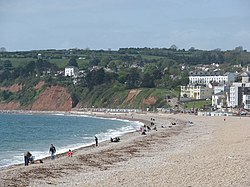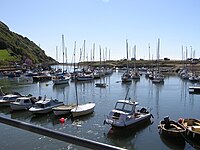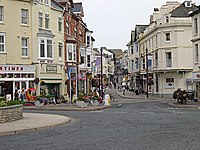Seaton, Devon: Difference between revisions
No edit summary |
No edit summary |
||
| Line 49: | Line 49: | ||
In the 19th century Seaton developed as a holiday resort and many of the town buildings are Victorian. Seaton has many accommodation providers including guest houses, hotels, a camping site and a caravan park. | In the 19th century Seaton developed as a holiday resort and many of the town buildings are Victorian. Seaton has many accommodation providers including guest houses, hotels, a camping site and a caravan park. | ||
Seaton is also notable for having one of the world's first concrete bridges, built over the [[River Axe]] in 1877, by the Seaton and Beer Railway company. This is one of the earliest concrete bridges in Britain.<ref name=phillips/> | Seaton is also notable for having one of the world's first concrete bridges, built over the [[River Axe, Devon|River Axe]] in 1877, by the Seaton and Beer Railway company. This is one of the earliest concrete bridges in Britain.<ref name=phillips/> | ||
==Natural history== | ==Natural history== | ||
Latest revision as of 10:04, 27 October 2018
| Seaton | |
| Devon | |
|---|---|
 Seaton beach | |
| Location | |
| Grid reference: | SY239900 |
| Location: | 50°42’17"N, 3°4’39"W |
| Data | |
| Population: | 7,111 (2004 est.) |
| Postcode: | EX12 |
| Dialling code: | 01297 |
| Local Government | |
| Council: | East Devon |
| Parliamentary constituency: |
Tiverton and Honiton |
Seaton is a seaside town in Devon, in the very east of the county on the south coast. It faces onto Lyme Bay, to the west of the mouth of the River Axe with red cliffs to one side and white cliffs on the other. Axmouth and Beer are nearby. A sea wall provides access to the mostly shingle beach stretching for about a mile, and a small harbour.
Its pleasant sea air and relaxed mien has made Seaton a popular town for retired folk.
Seaton sits on the 96-mile long Dorset and East Devon Coast World Heritage Site, more commonly known as the Jurassic CoastCite error: Invalid parameter in <ref> tag. From here it is possible to visit rock strata dating from three geological periods in a 185 million-year ‘geological walk through time’.
Churches
The parish church is St Gregory's and it stands on the edge of town, built long before the town grew with holidaymakers.
The church is of the 14th century, with a squat tower dating from the 15th century.
Churches in the town include:
- Church of England:
- Baptist: Seaton Baptist Church
- Independent Evangelical: Crossroad Christian Fellowship
History

A farming community existed here 4,000 years before the Romans arrived and there were Iron Age forts in the vicinity at Seaton Down, Hawkesdown Hill, Blackbury Camp and Berry Camp. During Roman times this was an important port although the town's Roman remains have been reburied to preserve them.[1]
In Anglo-Saxon times Seaton was known as Fluta or Fleet, the Saxon Old English word for a floating creek. The town of Fleet was founded by a royal charter 1005 AD. The first mention of the name "Seaton" was in a mediaeval Papal Bull by Pope Eugenius in 1146.
Seaton was an important port for several centuries, supplying ships and sailors for Edward I's wars in Scotland and France. In the 14th century heavy storms caused a landslip which partially blocked the estuary, and the shingle bank started to build up. In 1868 the arrival of the railway reduced the use of the harbour.

Railway
Seaton was served by a branch line, opened in 1886, from Seaton Junction on the Salisbury to Exeter main line. The railway was successful and considerably assisted in the development of Seaton as a holiday destination. Seaton and Beer became the two most popular hoiday destinations in East Devon. A Warners holiday camp opened in 1935 close to the station, encouraged by the ease of travel.[2]
Like many other Devon branch lines, the railway closed in 1966 and part of the trackbed has been used to construct the Seaton Tramway to Colyton, a tourist attraction.
Holiday resort
In the 19th century Seaton developed as a holiday resort and many of the town buildings are Victorian. Seaton has many accommodation providers including guest houses, hotels, a camping site and a caravan park.
Seaton is also notable for having one of the world's first concrete bridges, built over the River Axe in 1877, by the Seaton and Beer Railway company. This is one of the earliest concrete bridges in Britain.[2]
Natural history
Geology
As befits a 'gateway town' to the world heritage site, the coastal cliffs either side of Seaton have long been of interest to geologists. To the East are the characteristically red-coloured cliffs of Triassic age rocks assigned to the Branscombe Mudstone Formation, capped by younger rocks (Cretaceous) of the Upper Greensand Formation and finally by Chalk. West of the town, the Seaton Fault is responsible for the presence of significant chalk cliffs extending to Beer Head. In common with much of this coast the cliffs in this area are prone to landslip and collapse, such movement restricting coastal development and presenting a hazard to those walking the coast.[3]
Wildlife

The area around Seaton is rich in wildlife. The agricultural landscape supports areas of ancient woodland (often with displays of bluebells), important networks of hedges, unimproved grassland and springline mires.
Around Beer there are remnants of flower-rich chalk grassland, a rare habitat in Devon. The Axe Estuary, with its areas of grazing marsh, and the River Axe itself, are of international importance for their aquatic communities. To the east lies the Axmouth to Lyme Regis Undercliffs National Nature Reserve. This large area of coastal landslides and cliffs supports important woodland and grassland habitats and is of considerable significance for its geology, as witnessed by its inclusion in the Jurassic Coast World Heritage Site.
Otters are present on the River Axe, and at the end of 2009 are being seen regularly on Seaton marshes/Colyford Common. Dormice are present throughout the area. To the west, near Beer, are man-made caves of importance for a diversity of hibernating bats, including the very rare Bechsteins bat. The Axe Estuary and its marshes are important for wintering wildfowl and waders, such as Curlew and Redshank, while in the summer butterflies and dragonflies abound.
The bird-watching and wildlife areas of the Axe Vale have been enhanced by the establishment of the Seaton Marshes Local Nature Reserve, work to establish it was carried out by the Axe Vale and District Conservation Society. In 2007, an Audouin's Gull was seen here - the fourth British record of this bird.
Attractions
The Seaton Tramway takes visitors across country to Colyford and Colyton. It runs alongside the estuary giving views of the nature reserve on one side and the estuary wildlife on the other.
At Beer, about 2 miles west of Seaton, is the Beer Heights Light Railway; along with numerous model railways this is part of Pecorama, a tourist attraction provided by the model railway manufacturer Peco.

Outside links
| ("Wikimedia Commons" has material about Seaton, Devon) |
References
- ↑ Romans – Seaton Museum
- ↑ 2.0 2.1 Derek Phillips, From Salisbury to Exeter: The Branch Lines, Oxford Publishing Company, Shepperton, 2000, ISBN 0 86093 546 9
- ↑ British Geological Survey 2005 1:50,000 geological map sheet (England & Wales) 236 & 240 Sidmouth, & corresponding memoir, Keyworth Nottingham
